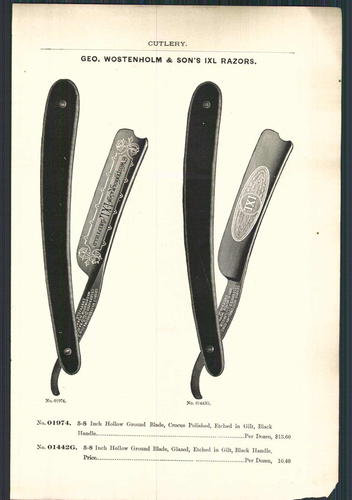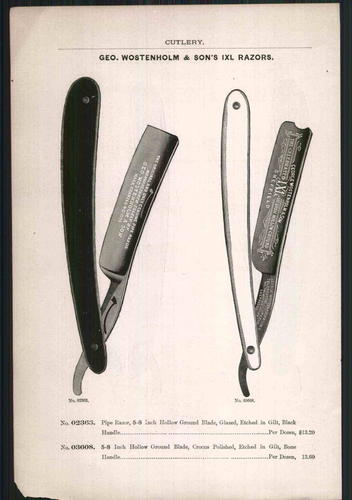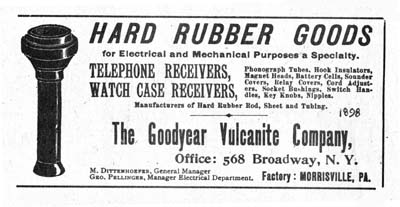Results 1 to 8 of 8
 6Likes
6Likes
Thread: 1890 Wostenholm catalog ads
-
04-05-2012, 01:18 PM #1Historically Inquisitive



- Join Date
- Aug 2011
- Location
- Upstate New York
- Posts
- 5,782
- Blog Entries
- 1
Thanked: 4249 1890 Wostenholm catalog ads
1890 Wostenholm catalog ads


-
The Following User Says Thank You to Martin103 For This Useful Post:
Joed (04-05-2012)
-
04-05-2012, 02:48 PM #2

From the same catalog:


-
The Following User Says Thank You to manah For This Useful Post:
Joed (04-06-2012)
-
04-05-2012, 03:02 PM #3

If only you could purchase a dozen razors for that now
-
04-05-2012, 03:57 PM #4

In this thread you can find many razors for the similar prices.

http://straightrazorpalace.com/razor...d-catalog.html
-
04-05-2012, 06:56 PM #5

Hmmm rubber handles I'm wondering how that would feel in my hand. If it feels anything like the old solid bike tires don't think I would like it, but for that price I'd take a dozen.
-
04-05-2012, 08:14 PM #6
 rubber handles I'm wondering how that would feel in my hand. If it feels anything like the old solid bike tires don't think I would like it
rubber handles I'm wondering how that would feel in my hand. If it feels anything like the old solid bike tires don't think I would like it
How about ebonite/vulcanite handles?
"Ebonite is a brand name for very hard rubber first obtained by Charles Goodyear by vulcanizing rubber for prolonged periods. It is about 30% to 40% sulfur. Its name comes from its intended use as an artificial substitute for ebony wood. The material is known generically as hard rubber and has formerly been called "vulcanite",although that name now refers to the mineral vulcanite."
So, rubber handles in old catalogs mean the ebonite handles.
And I hope, you've seen such handles.
-
04-05-2012, 08:26 PM #7

Ok I was thinking of that soft but hard feeling like in tire retreads not the plastic like feeling.
-
04-05-2012, 10:04 PM #8Historically Inquisitive



- Join Date
- Aug 2011
- Location
- Upstate New York
- Posts
- 5,782
- Blog Entries
- 1
Thanked: 4249
EBONITE and VULCANITE
 The discovery that rubber could be hardened by reacting it with chemicals under heat produced two useful compounds that could be readily moulded into electrical parts. Ebonite (rubber cured with mercury) was patented in Britain by Thomas Hancock in 1844, although it was probably invented slightly before Charles Goodyear's U.S. invention of vulcanite (rubber cured with sulphur) patented in 1839. Although adequate for their purpose, these substances were also flammable, weathered to an unattractive colour, and were not always dimensionally stable. In some cases it was necessary to machine them to an accurate finish, increasing the cost again. These two compounds were mainly used for terminal blocks, receiver caps, and other minor non-electrical or low-voltage parts. Rubber underwent a tremendous surge in demand, particularly for insulating electrical cables. Existing cast-moulding techniques were ideally suited for these compounds, but the extended heating and curing period needed in the moulds made production rather slow.
The discovery that rubber could be hardened by reacting it with chemicals under heat produced two useful compounds that could be readily moulded into electrical parts. Ebonite (rubber cured with mercury) was patented in Britain by Thomas Hancock in 1844, although it was probably invented slightly before Charles Goodyear's U.S. invention of vulcanite (rubber cured with sulphur) patented in 1839. Although adequate for their purpose, these substances were also flammable, weathered to an unattractive colour, and were not always dimensionally stable. In some cases it was necessary to machine them to an accurate finish, increasing the cost again. These two compounds were mainly used for terminal blocks, receiver caps, and other minor non-electrical or low-voltage parts. Rubber underwent a tremendous surge in demand, particularly for insulating electrical cables. Existing cast-moulding techniques were ideally suited for these compounds, but the extended heating and curing period needed in the moulds made production rather slow.


 LinkBack URL
LinkBack URL About LinkBacks
About LinkBacks






 Reply With Quote
Reply With Quote